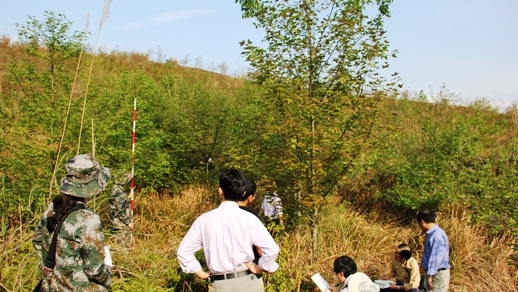First temporary certified credits for reforestation issued in China
BEIJING, December 28, 2012 - A project that has reforested 3,000 hectares of previously barren land in China’s southwest Guangxi is issuing its first carbon credits under the Clean Development Mechanism. The Facilitating Reforestation for Guangxi Watershed Management in Pearl River Basin Project was the first reforestation project to be registered in the world under the United Nations Framework Convention on Climate Change, which yesterday issued 131,964 temporary Certified Emission Reductions.
“With fast restoration and expansion of forest areas in recent years, China has great potential for carbon sequestration through afforestation and reforestation. The Guangxi project has demonstrated an innovative and effective approach to mitigating climate change,” said Klaus Rohland, World Bank’s Country Director for China.
The Guangxi Watershed in the Pearl River Basin, one of the richest and most diverse areas in terms of flora in the country, suffered greatly from deforestation since the 1950s. This, in addition to grazing, frequent fires and the use of wood for fuel, caused severe degradation of the original native forest. Despite efforts to restore forests in the 1990s, many areas remained either bare or sparsely populated with trees.
Supported by the provincial and local governments, local farmer communities are working with Kangyuan and Fuyuan forest farms, Xinghuan Forestry Development Company and Luhuan Forestry Development Company to restore the forest by planting mostly native species. Reforestation in this degraded region has played a vital role in terms of biodiversity, soil, and water conservation. The plantations established along the Pearl River, the third longest river in China, support both conservation and watershed management by controlling water erosion, and enhance biodiversity by improving habitats, increasing the connectivity of forests adjacent to nature reserves.
On a local level, the project uses innovative approaches, by enabling the carbon sequestered by trees to act as a “virtual cash crop”. Communities benefit from the direct income from the sale of the carbon credits to the World Bank’s BioCarbon Fund and from the products such as resin that the trees provide. Together, the villages decide which projects will be implemented, and local forestry companies provide them with training and technical services. In addition to providing a steady income from the sale of carbon credits and forestry products, the project will be able to involve about 15,000 local farmers in the planting and maintenance process, creating about 3.8 million person-days in temporary jobs and 30 long-term job positions over the 30-year crediting period.
The project has also raised the awareness of climate change among villagers. “We never realized that we could benefit from selling fresh air,” said 47-year old Tan Jiming from Leyi Village in Huanjiang County of Guangxi. Registered in 2007, this project helps to demonstrate that carbon revenues can enhance the long-term financial sustainability of a project as well as building forestry management capacity at both central and provincial levels. In 2010, the China Green Carbon Foundation was launched following this same approach of greenhouse gas (GHG) sequestration through reforestation.
“This project has attracted the attention of different sectors and regions, and we have seen a steady stream of visitors from other parts of China and abroad. We are very pleased to have shared our experience and lessons learned - it has really played a demonstrative role as a successful pilot project,” said Li Guiyu, Director of the Project Management Office in the Guangxi Forestry Bureau.
Useful Facts:
The Clean Development Mechanism (CDM) of the United Nations Framework Convention on Climate Change (UNFCCC) is one of the flexible mechanisms of the Kyoto Protocol intended to reduce the concentration of greenhouse gas emissions in the atmosphere in a cost-effective manner. The CDM allows emission-reduction (or emission removal) projects in developing countries to earn certified emission reduction (CER) credits, each equivalent to one metric ton of carbon dioxide. These CERs can be traded and sold, and used by industrialized countries to meet a part of their emission reduction targets under the Kyoto Protocol.
The World Bank’s BioCarbon Fund, created in 2004, is purchasing credits from over 20 afforestation and reforestation projects under the CDM in more than 16 countries and five regions of the world. The Fund’s resources are allocated to projects on degraded lands: half to projects with environmental restoration purposes, 25 percent for fuel-wood and 21 percent for timber. All of the projects directly benefit poor farmers; in most of them, farmers are planting their own lands.

